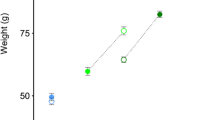Abstract
A triennial performance test of five groups of tench, Tinca tinca (L.): Vodnany induced triploid V3n, Vodnany meiotic gynogenic Vgyn, diploid Vodnany V2n, Hungarian H2n and German G2n) in pond monoculture was carried out with diploid golden tench as control (C) to compute corrected weight of the groups tested. Survival rate ranged from 11.6% (V2n) to 30.6% (Vgyn) in yearlings, from 71.2% (V2n) to 91.5% (H2n) in 2 year-olds, from 60.0% (Vgyn) to 75.7% (V2n) in 3 year-olds while that of the control group was 8.5, 38.3 and 40.2% in the respective seasons. After three growing seasons the corrected weight of the fish in the groups H2n (254.6bg), V3n (257.0cg) and G2n (371.4cg) was higher (P < 0.05, Tukey HSD test) than that from the C (183.3ag) and V2n(205.6abg) groups. Among the chromosomally manipulated groups, ANCOVA test found the least slaughtering value for Vgyn (84.3%); among the purebreds the highest value was found for H2n (87.32%), significantly differing from V2n and G2n strains. A high gonadosomatic index in females (2.94 vs. 0.44% in males) resulted in inferior slaughtering values.
Similar content being viewed by others
References
Benfey TJ (1999) The physiology and behaviour of triploid fishes. Rev Fish Sci 7:39–67
Billard R, Flajshans M (1995) The current state of research and culture of tench. Tinca tinca (L.). Concluding remarks on the workshop. Pol Arch Hydrobiol 42:219–225
Buchtová H, Svobodová Z, Flajšhans M, Vorlová L (2003) Analysis of growth, weight and relevant indices of diploid and triploid group of tench, Tinca tinca (L.). Aquacult Res 34:719–726
Flajšhans M, Linhart O (2000) Production of triploid tench. Manuals of Research Institute of Fish Culture and Hydrobiology, University of South Bohemia, Vodňany 62:14 (in Czech)
Flajšhans M, Linhart O, Kvasnička P (1993) Genetic studies in tench (Tinca tinca L.). Artificial induction of triploidy and tetraploidy. Aquaculture 113:301–312
Flajšhans M, Kocour M, Gela D, Piačková V (2004) The first results on interactions among diploid, gynogenic and triploid tench, Tinca tinca (L.) under communal testing. Aquacult Int 12:103–118
Gela D, Linhart O (2000) Evaluation of slaughtering value of common carp from diallel crossing. Czech J Anim Sci 45:53–58
Gela D, Linhart O, Flajšhans M, Rodina M (2003) Egg incubation time and hatching success in tench, Tinca tinca (L.) related to the procedure of egg stickiness elimination. J Appl Ichthyol 19:132–133
Hulata G (2001) Genetic manipulations in aquaculture: a review of stock improvement by classical and modern technologies. Genetica 111:155–173
Kocour M, Linhart O, Gela D (2003) Results of comparative growing test of all-female and bisexual group in two-year-old common carp, Cyprinus carpio (L.). Aquacult Int 11:369–378
Kvasnička P, Linhart O (1990) Results and programme of tench, Tinca tinca (L.) breeding. Práce VÚRH Vodňany 19:47–59
Lecommandeur D, Haffray P, Philippe L (1994) Rapid flow cytometry method for ploidy determination in salmonid eggs. Aquacult Fish Manage 25:345–350
Linhart O, Kvasnička P, Flajšhans M, Kasal A, Ráb P, Paleček J, Šlechta V, Hamáčková J, Prokeš M (1995) Genetic studies with tench, Tinca tinca L.: induced meiotic gynogenesis and sex reversal. Aquaculture 132:239–251
Linhart O, Gela D, Flajšhans M, Rodina M (2000a) Artificial propagation of tench using an enzyme for egg desticking. Manuals of RIFCH USB Vodňany 65:14 (in Czech)
Linhart O, Gela D, Flajšhans M, Duda P, Rodina M, Novák V (2000b) Alcalase enzyme treatment for elimination of egg stickiness in tench, Tinca tinca (L.). Aquaculture 191:303–308
Linhart O, Gela D, Rodina M, Šlechtová V, Šlechta V (2002) Topcrossing with paternal inheritance testing of common carp (Cyprinus carpio L.) progeny under two altitude conditions. Aquaculture 204:481–491
Linhart O, Gela D, Flajšhans M, Rodina M (2003a) Proteolytic enzyme treatment: an impoved method for elimination of egg stickiness in tench, Tinca tinca (L.) in aquaculture. J Appl Ichthyol 19:134–137
Linhart O, Rodina M, Gela D, Flajšhans M, Kocour M (2003b) Enzyme treatment for elimination of egg stickiness in tench, Tinca tinca (L.), European catfish, Silurus glanis (L.) and common carp, Cyprinus carpio (L.). Fish Physiol Biochem 28:507–508
Linhart O, Rodina M, Kocour M, Gela D (2006) Insemination and gamete management in tench, Tinca tinca (L.). Aquacult Int 14(1–2):61–73
Pandian TJ, Koteeswaran R (1998) Ploidy induction and sex control in fish. Hydrobiologia 384:167–243
Rennert B, Kohlmann K, Hack H (2003) A performance test with five different strains of tench Tinca tinca (L.) under controlled warm water conditions. J Appl Ichthyol 19:161–164
Rodina M, Cosson J, Gela D, Linhart O (2004) Kurokura solution as immobilization solution for spermatozoa of tench, Tinca tinca (L.). Aquacult Int 12:119–131
Steffens W (1995) The tench, Tinca tinca (L.), a neglected pond fish species. Pol Arch Hydrobiol 42:161–180
Wang J, Min W, Guan M, Hu S (2006) Tench farming in China: present status and future prospects. Aquacult Int 14:205–208
Acknowledgments
This research was supported by the USB RIFCH project No. MSM6007665809 and GA523/08/0824.
Author information
Authors and Affiliations
Corresponding author
Rights and permissions
About this article
Cite this article
Gela, D., Kocour, M., Flajšhans, M. et al. Comparison of performance of genome manipulated and standard tench, Tinca tinca (L.), groups under pond management conditions. Rev Fish Biol Fisheries 20, 301–306 (2010). https://doi.org/10.1007/s11160-009-9142-1
Received:
Accepted:
Published:
Issue Date:
DOI: https://doi.org/10.1007/s11160-009-9142-1



